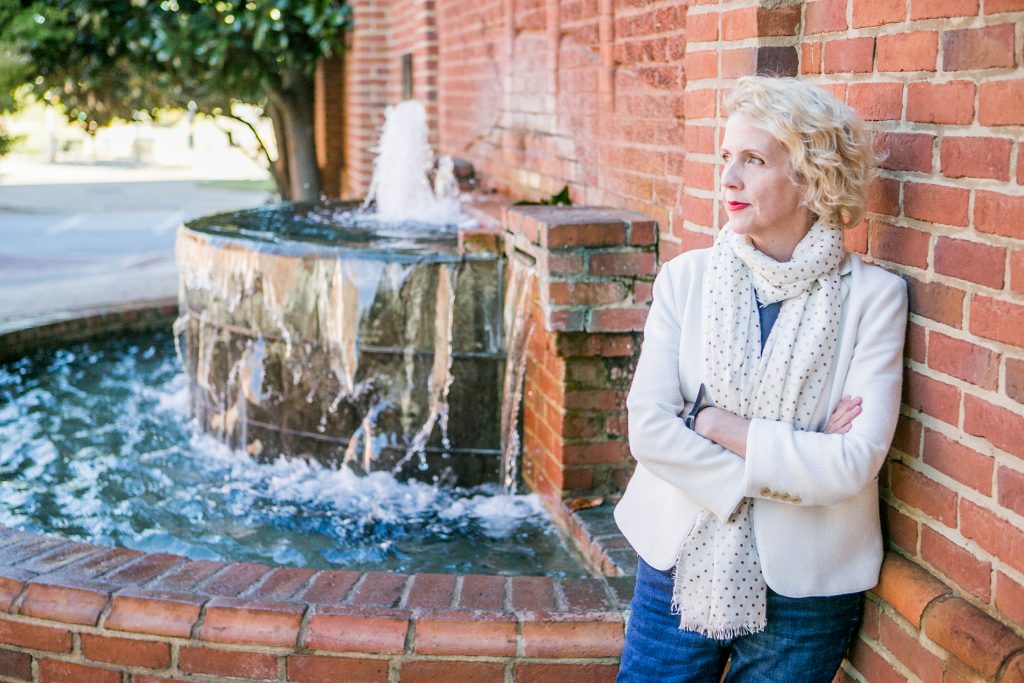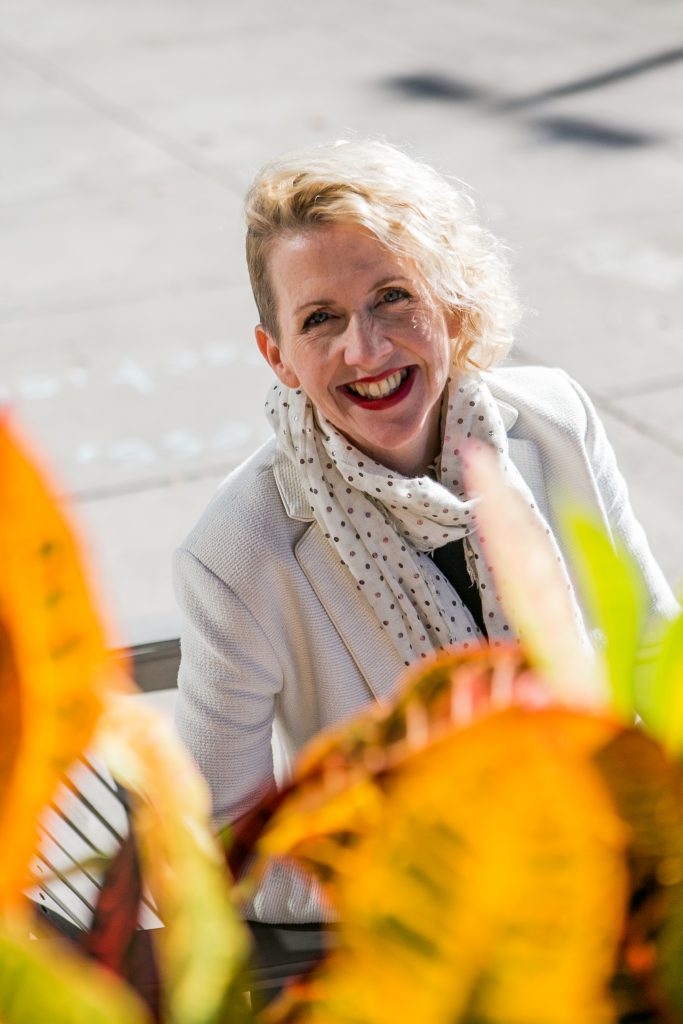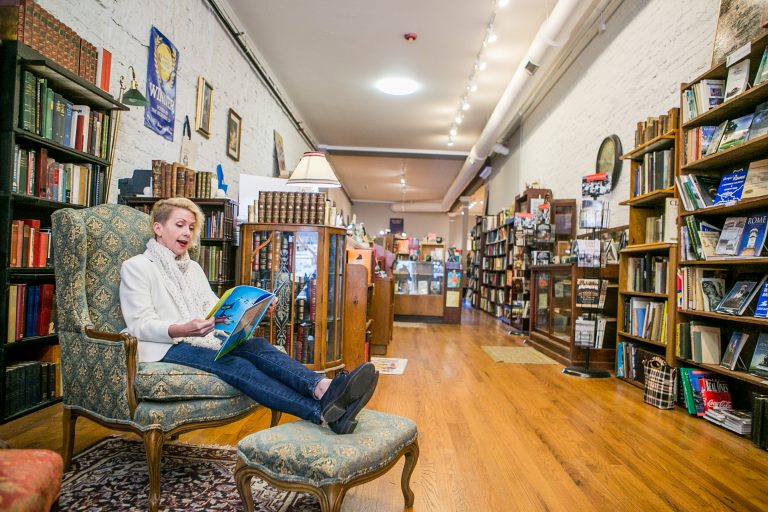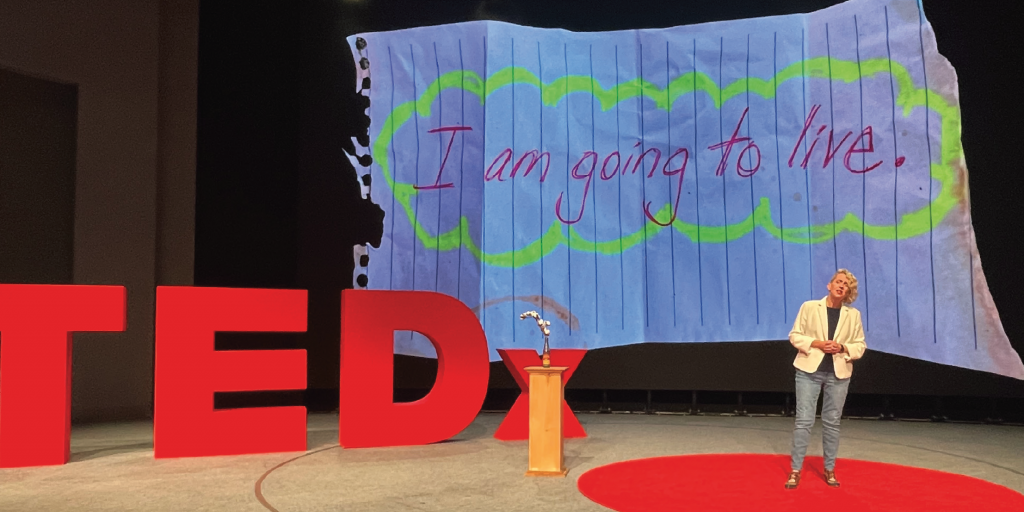
Photos Rob Smith
Lauretta Hannon is a hoot. THAT STATEMENT—that Southernism—doubtless expresses the sentiment of many fans of her writing, radio spots, lectures, seminars, podcasts, and workshops. But to stereotype this multi-talented woman as a “humorist” misses the bigger picture. Yes, she can make readers laugh out loud as they sit alone, book in hand. She can also bring an audience to the brink of rolling hysterics with her home-spun anecdotes and colorful aphorisms, all told in an authentic rural drawl that she describes as sounding “like cornbread and collard greens.” Funny. She is that. But there’s more to her life and work than just laughs.
A lot more. There’s a sort of therapeutic magic in the things she does. It’s medicinal merriment. Her words and style were forged in the crucible of a common human experience: pain. The exuberance rises from—and is tempered by—suffering. That is the bonding factor between herself and her followers. With a pithy economy of words, often hilarious, always poignant, Hannon invites her readers, students, and hearers to identify with her as she encourages them to trust their talent and keep on trying.
A decision to live
Hannon’s childhood was a mixed bag. On one hand, she received a great deal of love. “I knew I was cherished,” she says, “so there was a lot of good there.” On the other hand, she also describes those years as a “torrent of curses.” As she puts it, “My father and mother got together, deeply in love, but each brought a bunch of pain that they hadn’t worked through yet. That became combustible.”
Hannon’s father was a classically trained musician who played an array of instruments but found his true passion in jazz saxophone. When her mother descended into the depths of alcoholism and mental illness, Hannon found her stability in her father. “When I was seven years old my parents got divorced,” Hannon says, “and, unfortunately, my mother continued her bad habits, and Daddy decided to change some things and be there for me. And he stuck to that.” Numerous childhood photographs testify to that, showing the little girl huddled close to her father. “He was my alpha and omega,” she says, “my everything.”
When Hannon was 17, she experienced a devastating reversal of fortune. On the morning of New Year’s Day, her father had a massive heart attack in front of her. He died about an hour later in the ER. “My whole world had just been decimated, annihilated,” she says. In the wake of this loss, she found herself at a dark crossroads. She could follow the way that led to a fear-based life, or she could strike out in a more hopeful direction.
To work through this personal trauma, she turned to something that had become a source of strength for her. Words. “I knew I had a decision to make: I could try to live or I could merely exist and endure. I wrote in my notebook ‘I am going to live.’ Even though I was shattered into a million pieces, I was going to try to do some things that scared me. I would be terrified, but I would do them anyway.”

The bullying power of believing a lie
After her father’s death, a series of experiences alternately bolstered and sabotaged her determination to keep that promise— “I am going to live” —to herself. After high school, she went to Europe for the summer, arriving with only $500 in her pocket. She hitchhiked through Europe, playing her flute on the street to raise funds for her travels as she went. She celebrated her 18th birthday in London. Then it was time for college. By the time she arrived on the campus of the University of Georgia, she considered herself quite the savvy world traveler, and she was ready to dive in and continue her exploration of the world through great books. She studied comparative literature, with an emphasis on the work of Spanish authors.
While applying for grad school, Hannon solicited a letter of recommendation from her favorite professor, an educator whom she idolized. Carrying his sealed letter, she had an unsettling premonition about its contents. Though it violated the protocols of secrecy, she tore the envelope open and read the professor’s words, which were, “Lauretta Hannon is a mediocre writer.” Devastated, she believed him. For the next 15 years, she resisted the desire to pursue a career in writing. She says, “In accepting that one sentence, I absolutely rejected my true calling, violated my dream of being a writer, and dismissed my destiny.”
The Cracker Queen
Despite Hannon’s deflated opinion of her writing skill, her damaged dream refused to remain buried. She explains, “Your purpose never abandons you no matter how hard you try to push it down. When you choose to believe a lie about your very soul, your calling will not leave you alone.”
More than a decade after reading that professor’s fateful, hurtful words, Hannon reluctantly submitted a story to Georgia Public Radio. To her surprise, they accepted it. She was pleased but assumed it was a fluke. It was five years later before she submitted another story, this time to National Public Radio. They too said “Yes”. What’s more, this exposure on the radio prompted a call from a literary agent, who offered to represent her. Hannon was wary, but she listened. When the conversation finally got around to the heart of the matter, it went as follows:
Agent: “Lauretta, do you have a book?”
Hannon: “Sure do!”
Agent: “Great! Can you go ahead and send that to me?”
Hannon: “Well…I haven’t started it yet. But I will!”
At that, the needle on her soul’s confidence meter budged toward optimism. Just a bit. She wrote, “I am not the worst writer in the world.”
Bending to the work, she mined the depths of her childhood and wrote about the love and trials of growing up in a dysfunctional home. The finished product was entitled The Cracker Queen. “When it came to writing my memoir, everyone in my family begged me not to do it,” Hannon says. “They were on a tear, on a campaign to stop me.” She was most worried about her mother’s reaction, knowing that Hannon’s own memories would not coincide with the narrative her mother had been telling people for years. “Mamma was beautiful, but she was duplicitous,” Hannon says. “She created her own stories about what happened. So, she was going to have to face the truth or disown me.”
Hannon dealt with her apprehension by not showing her work to her mother until it was already at the printers, too late to change anything. “I sent her the manuscript, and she went right away into the one place she could have complete privacy, the loo,” says Hannon. “She sat on the toilet and read it through cover-to-cover. She couldn’t believe what she read.” After that, her mother went to bed but couldn’t sleep. She got back up, locked herself in the bathroom again, and reread the entire manuscript.” When the sun came up, she went into the kitchen, handed the memoir to her long-time partner, and said, “Bob, this is Retta’s book. It’s a hundred percent the truth, and I don’t give a damn what you think.” Over the years, Hannon’s mother’s admissions and denials ebbed and flowed, but she was always completely supportive of The Cracker Queen.
Eventually, Hannon’s plan to win her mother to her side worked a little too well. She finally had to stop taking her mother to author events, because her mother was so proud of being the Cracker Queen that she always took over the event, holding court for her public. Years later, when Hannon’s mother was fatally ill, she summoned her daughter to her and ordered her to never write another word about her. Hannon just burst out laughing and said, “Oh, Mamma, you’ve made that impossible.”
On the big red dot
Typically, a sign of true personal healing is found in summoning the courage to tell one’s own story, saying the truth out loud. Hannon has built a loyal following by doing just that. For instance, at a recent TEDx presentation at the Savoy Automobile Museum in Cartersville, Georgia, she told her tale of pain, passion, and perseverance to a rapt audience. She outlined some of the significant events in her life and explained how they related to her self-talk, what she believed—and came to believe—about herself. She unfolded a storyline that followed the theme of the “I am” statements that she has claimed for herself, for good or for ill, over the years.
“The words that follow ‘I am’ are very important things,” Hannon says. “They can be your sacrament, or they can be your undoing.” For Hannon herself, that has proven true. She has embraced some “I am” statements, others she has rejected: “I am going to live”; “I am a mediocre writer”; “I am not the worst writer in the world”; “I am an author, teacher, mentor.”
Today, Hannon is on a mission to help others finish their own “I am” sentence, to change the trajectory of their lives through the written word, and to learn to tell the truth about their lives and reject the lies. She leads her students in short, simple, reflective writing exercises that help them foster clarity in their thinking. “They come to me, or I go to them,” Hannon says. “In prisons. Youth detention centers. Accountability courts. Sacred contracts are everywhere.” She tells her story to give others the courage to tell theirs. “I like being people’s companion on this road of shadow and light. I know where the bandits are hiding on that road, so we can walk it together and get to the treasure at the end.”
For more information, go to laurettahannon.com. Her next workshop will be offered in 2023 at the Rome Area History Center. For details, please email hannonlauretta@gmail.com.


















